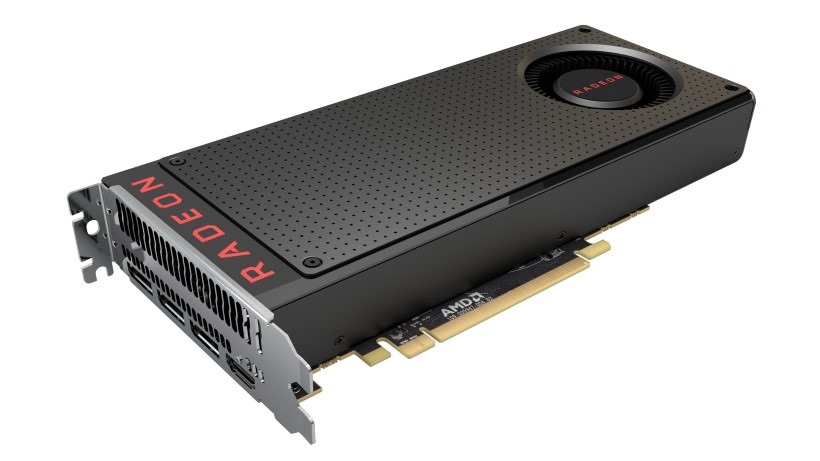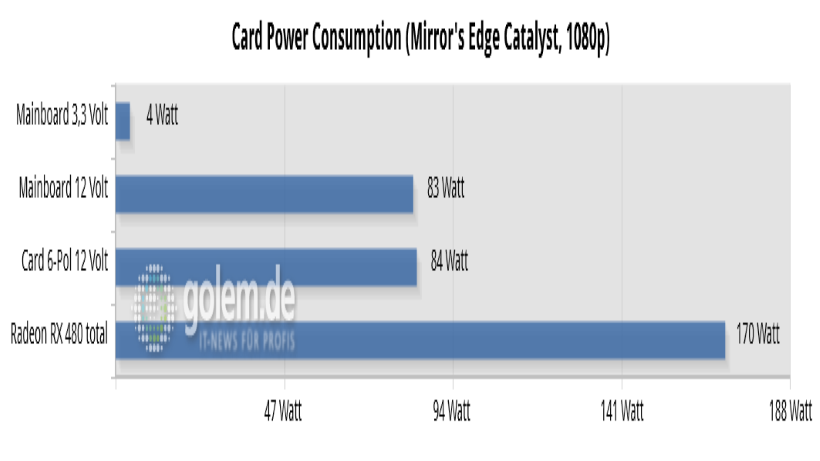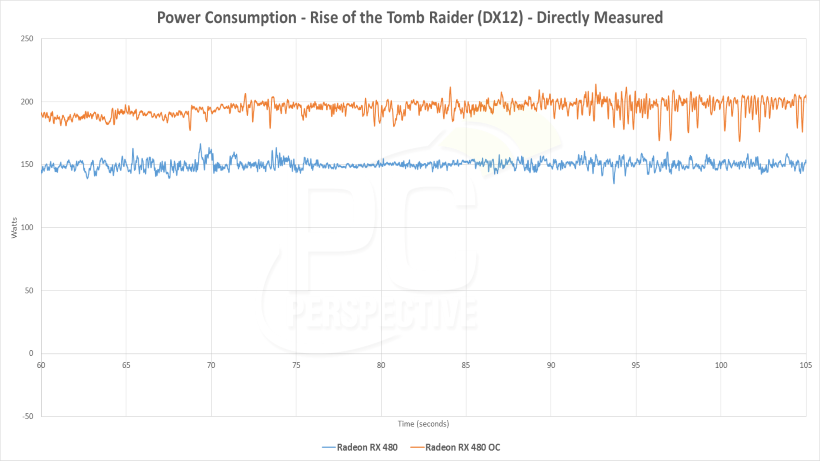So now that AMD has handily supplanted the GTX 970 with the RX 480 as the minimum required graphics card for VR, it seems like reality has bitten the card for it’s supposed power consumption irregularity. Don’t get us wrong; the card is an amazing poster dolphin AMD can gift to Al Gore’s solar powered PC, but just because it runs as fast as an R9 390 while using ~90W to do so does not mean that some irregularities have not been picked up by a few reviewers and their audience.

Irregular power numbers were brought up within a [H]ardForum RX 480 thread after being pointed out in a Tom’s Hardware review. It quickly gained traction on reddit with claims of violating the PCI-SIG compliance standard. The PCI-SIG is an Industry group that defines the PCI-E standard and tests products for compliance. This caused the likes of AMD’s Robert Hallock to comment and RTG CEO Raja Koduri (In an AMA) to calm people down while correcting some misinformation, while clearly trying to put out some PR fire.
The gist of the issue is this: AMD has stated on numerous occasions that the TDP for the RX 480 is 150W, essentially meaning that the card’s PCB design can use up to 150W depending on the usage and load scenarios. This stated TDP fits neatly into the actual PCB power delivery method on the RX 480: A single 6-Pin power is specified to deliver 75W at a maximum(even though it can deliver much more if pushed), while the PCI Express 3.0 slot is capable of delivering a maximum of 75W. Thus the 150W TDP on the RX 480 seems to fit snug with those standards.
Now most GPU makers (I.e, both AMD, NVIDIA and their board partners) usually balance out the delivery methods and often over-specify their PCI-Express requirements. For example, even though the GTX 970 is essentially a 145W TDP card, the power delivery options are two 75W 6-Pin power connectors and the PCI Express slot’s 75W, making the total power available to the PCB 225W (75W X 2 + 75W).In contrast to this 145W part, AMD’s 150W RX 480 part basically just has enough power delivery to cover 150W. One would think, to extend the established idea of over-specifying, that this could mean the card actually consumed less than 150W when under load.
However, this doesn’t seem to be anywhere near the case. It’s common for power consumption to spike over the specified wattage ratings; however the difference is that according to reviewers and some tech savvy consumers, they’ve recorded power consumption of the RX 480 as consistently above the 75W maximum for the PCIe interface and 6-pin power connector. On Tom’s Hardware, they recorded 164W total with 86W through the PCIe slot while Golem.de recorded a maximum of 170W in Mirror’s Edge, with both the PCI express and 6-pin power connector drawing more than they should. This seemed to be the case for most reviewers with access to equipment capable of measuring power consumption, as they all point towards one conclusion: the reference RX 480 consumes more than its 150W stated TDP and is technically not PCI-E compliant.


What this means for now is still up in the air as we’ve not heard anything official from AMD. What this actually means in real world scenarios is a theoretical chance of some damage at worst or audio artifacts due to motherboard instability. More often just a reboot or two when a power spike goes to far for those with cheaper quality motherboards or power supplies.

The real thing that stuck out for me when reading reviews was the paltry overclocking results, and now I know why. Reviewers at PCPer.com, TechpowerUp, [H]ardforum and Tom’s Hardware all showed more or less the same type of power consumption under load. When overclocked, however, things got well out of hand on the power consumption front. Above is a graph from PCPer showing the increase in power consumption from overclocking while playing Tomb Raider. In plain terms, a card with a TDP of 150W is pulling close to 200W, and that’s just not right. Tom’s Hardware even avoided any long term overclocking since “the Radeon RX 480’s power consumption through the PCIe slot jumped to an average of 100w, peaking at 200W. We just didn’t want to do that to our test platform”. Overclocking these cards may not be the safest thing to do right now, let alone if you have RX 480 Crossfire and you’re pulling an extra 80W through your motherboard.
Robert Hallock is attempting to correct the apparent misinformation and do damage control by admitting that there may be some review RX 480s exhibiting “anomalous behaviour” and that they’re investigating the issues. An update to drivers has addressed an issue of power when the card is idling, but nothing as of yet regarding total TDP. One thing is clear though from reading reviews: this is definitely a card that can consume more than 150W of power and thus AMD should have made it either 2X6 pins or a single 8-Pin connector. I fear the allure of power efficiency that has given NVIDIA such market and mind share has played into AMD needing a “symbolic”150W power efficient card capable of achieving R9 390 performance; much like the GTX 970.
If this plays out the way I think it will AMD may have gimped their own card to cater towards the outward appearance of better Performance/Watt metrics instead of actually engineering an all-round solid card. I doubt anything legal will come from this as this is not the first time AMD has exceeded the PCI-E specification limits. Their HD 6990 was equally guilty and yet the PCI-SIG didn’t much care about it, and so why should we?
Well, we should in a round about sort of way—with the HD 6990, it was not compliant since it exceeded 300W and was an ultra-enthusiast card-I.e, this thing was made to be a power hungry gaming monster and “screw compliance I want moar FPS!!”. Conversely, the RX 480 is meant to be a “volume” product and “everyman”(Down with the 1%!!) GPU capable of great bang for buck performance for the mainstream market. The question then becomes: why did AMD decide on a single 6-pin configuration? Maybe the allure of finally having a 150W GPU capable of sticking it to NVIDIA’s GTX 970 clouded RTG’s judgement. Perhaps it was cost saving to standardise the PCB design since the PCB of the 4GB RX 480 is exactly the same as the 8GB version, and the 4GB RX 480 may consume less to stick to the 150W TDP. Perhaps they just did not anticipate Pascal’s gigantic leap forward in performance, and by extension their future cut down Pascal competitors (GTX 1060), and so they massively increased clockspeeds to squeeze as much performance as they could while trying to stick to the 150W TDP. It’s all quite fascinating.
Now the simple options available to AMD, if this proves to be something they have to remedy, is to merely update their cards with a lowered clockspeed to maintain 150W TDP or revise their cards with either an 8 Pin connector. Alternatively AMD could do nothing and leave it up to their AIB partners to release non-reference cards with a more ample power delivery design. Should we as consumers care? Let us know in the comments.
Last Updated: July 1, 2016





















Alien Emperor Trevor
July 1, 2016 at 08:14
Sorry AMD, I like you but this isn’t cool. You’ve gone in with the absolute bare minimum on this card wrt power consumption, and all you need is for a few systems to fail because of this and you’ll have a disaster on your hands that you can ill afford. You might be technically correct, but nobody gives a damn about that.
http://i.imgur.com/10lkUdy.gif
Kromas GG
July 1, 2016 at 09:05
Good thing only suckers (read early adopters) ever buy reference cards. Does not matter if you side with AMD or Nvidia. You never buy reference.
Viper_ZA
July 1, 2016 at 10:44
Got burnt by the R9 290 in that regard, now a proud owner of an aftermarket gtx980 xD
Kromas GG
July 1, 2016 at 11:02
Yeah got burned myself many moons ago. Now I try to be patient.
Spy Master Tokashi
July 1, 2016 at 09:57
Only stupid people buy reference cards anyway and if the cards are faulty unlucky BUT reference models do pave the way for the AIB cards and it is good marketing.
AMD fked up big time and the fact that they try to throw it under the carpet just caused me to shift over to NVIDIA. Why on earth did they decide to give it only a 6 pin power connect is beyond me… bragging rights?
Hey look, we can deliver a better performance card with less power required … OH SHIT, but it might fry your MOBO … HAHAH YOLO, F U STUPID AMD FANBOY
I would rather support greedy bastards then scaly BS PR wankers that over hype shit .
I am sad though because AMD just paved the way for NVIDIA to be kings of the PC GPUs again. They make it so easy for them … sigh
GmailIsDown
July 3, 2016 at 21:30
in an attempt to give the illusion of efficiency AMD has created the ultimate motherboard killer. good job.
James Anderton
July 1, 2016 at 08:21
So GTX 970 or fry my board thanks to AMD?
I think I’ll stick with my 970, thanks.
Pariah
July 1, 2016 at 08:24
I think the 1060 has a good opportunity here to oust the AMD card. Let’s see what Nvidia does.
Spy Master Tokashi
July 1, 2016 at 09:58
wait wait, they said that the RX 480 is best bang for bucks … wait…
It will definitely bang your MOBO in the PCI and then you have to use some bucks to get a new PC 🙂
Dane
July 1, 2016 at 14:53
‘A’ for effort.
Kikmi
July 1, 2016 at 09:48
topkek
Dane
July 1, 2016 at 10:18
I feel like there is not one gamer in the world who, knowing this information and installing this card, would not glare at their tower every 10 minutes to make sure it’s not on fire.
So no. It’s not ok. I don’t want a destructive piece of hardware in my computer.
Deceased
July 1, 2016 at 11:03
Aftermarket cards would solve this 😐
( Shouuw the salty green bastar… I mean team… is real )
( Edit: team – I meant salty green team )
GmailIsDown
July 3, 2016 at 21:32
actually they will, by adding just one more 75W 6-pin connector. i believe AMD should issue a recall for their irresponsible decision.
Mr_Pops
July 1, 2016 at 11:11
So this may be a bit of a noob question but is this something that’s likely to be fixed with the AIB cards? Because all of them that I’ve seen so far seem to be based on the reference design.
Marco
July 1, 2016 at 23:37
It seems like non-reference AIB cards will more than likely have enough power connections to the PCB.
DisqusCommenter
July 1, 2016 at 21:02
Anyone with a functioning brain could figure out something was wrong with the rx 480 reference design. tdp 150 watts and you are only going to use the bare minimum for power connectors. 75 watt 6 pin and 75 watt pcie bus. Unless the card was designed to draw like 125 watts or less so there is a 25 watt buffer… the card was going to overdraw which is bad in pretty much all cases. This is more a likelihood considering they were pushing overclocking and all that.
It is more likely than not they designed it to use around that 125 watts or something less but couldn’t get higher clocks stable. They bumped the voltage at the last minute to reach higher stable clocks which causes the card to be less power efficient and overdraw more often than naught.
The one thing I’m more curious about is how did it pass pcie sig external testing unless there was some deceit on AMD part sending them a batch of cards for testing that actually weren’t what was going to be sold to consumers. If that is the case, then AMD is going to be in a shit storm than just recalling video cards to fix the issue.
You are then getting into the realm of consumer fraud cases and getting banned from using pcie compliant trademark which would pretty much eliminate all progress AMD has made. There are standards for a reason and if the video card isn’t staying within the standards that is a huge problem.
Problem is not too many people own a device or know how to measure electricity from the pcie lane directly. They would be using the video card for awhile and suddenly their motherboard could be damaged with no real indications of why.
A big review site should go out and buy like 10 – 20 rx 480s and test all of them. If more than 2 of them have this electricity problem, then I’d say it’s the norm and not the exception. You can always return the video cards if the hardware isn’t compliant and is going to damage your motherboard. Of course if they end up not overdrawing on power, then you’d be stuck with a bunch of functioning rx 480s.
David Rhee
July 2, 2016 at 08:38
A reference card is supposed to be more reliable and more tested being direct from the manufacturer.
Consumers buy reference designs because of the implied trust in the manufacturer.
AMD is going to lose its reputation as evidence of burnt motherboards is coming in.
No matter what a EULA states, the design is not fit for purpose, if software tuning (aka moderate overclocking) or intensive application usage damages the card or other system components.
AMD should declare a recall before they’re forced by consumer protection agencies in the US and world-wide.